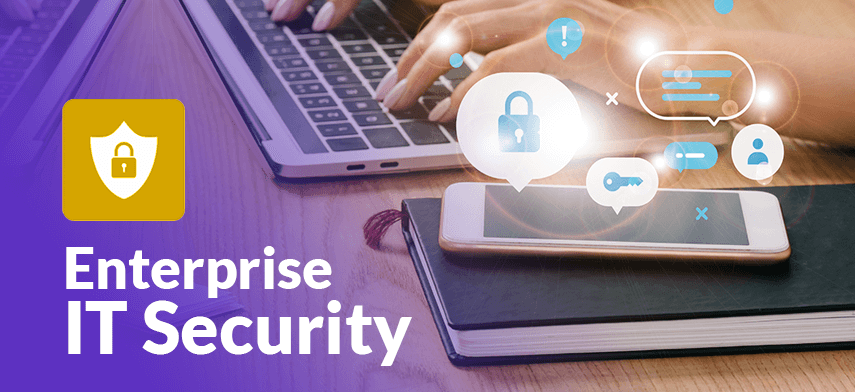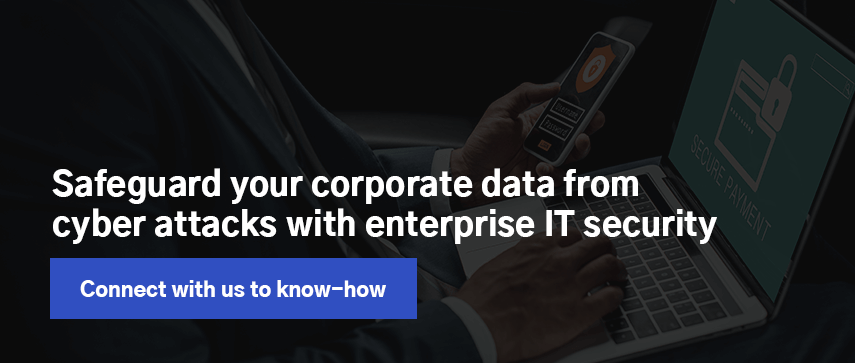The COVID-19 has forced enterprises to quickly embrace innovative technologies to perform better and survive in today’s cut-throat competition. This reliance on technology has accelerated digital transformation across business verticals, furnishing a huge opportunity to cyber attackers worldwide. Today, we will discuss the same in detail and the best practices to safeguard your enterprise from cyber attacks.

We all know that 2020 witnessed the world’s first-ever mass migration towards digitization because everything shifted online – from people, processes, data to infrastructure. This type of situation is ideal for any cyber hackers. As a result, they had myriad opportunities to break down enterprise IT infrastructure. And they did it by implementing several innovative tactics for different enterprise systems. Let’s see what happened to them in 2020.
Enterprise Security Challenges Amidst the Pandemic
Everyone around the world was trying to cope with the crisis. Simultaneously, the security professionals of the enterprises kept safeguarding the enterprise system. Reason being that the adoption of remote work arrangements by enterprises provided a fertile environment for cybercrimes.
Additionally, cyber criminals used technologies more effectively to harm enterprise safety, exploit corporate data, networks, and ultimately damage economies. They targeted industries such as healthcare, pharmaceutical, financial, retail, education, research organizations, and local government since they all deal heavily with confidential information. Talking about the healthcare industry, 9,710,520 healthcare records were exposed in September 2020, as per HIPPA Journal.
Going further, Google’s Safe Browsing Service Report indicates a steady increase in the number of phishing sites. At the end of January 2020, Google detected 1,690,000 phishing sites by the end of April, and the number grew to 1,900,000.97.
Companies like Twitter, Marriott, Zoom, Greek Banking System also suffered from the biggest cyber attacks during the pandemic. And still, we come across various media reports on companies hit by cyber-attacks on a daily basis. This is one of the most critical barriers to growth for enterprises.
Because these cyber security threats come with a lasting financial impact on enterprises, the cost includes loss of data, theft of intellectual property, reputation damage, loss of productivity, etc. Eventually impacting the entire economy.
Growing Enterprise Security Concerns Driven by Remote Work
The remote working trend has the most significant impact on security as the home internet connection is not as secure as the fortified offices, having secure firewalls run by security experts. Likewise, the confidential data, files, folders, etc., are distributed at various locations of workers that need to be protected.
Furthermore, many employees use personal devices such as mobile phones, home computers, or laptops with no enterprise-level security to access the system or attend remote working calls. Cyber attackers can breach such devices and get access to the network quickly.
Despite this rising concern, many enterprises, including SMBs, have not provided a ‘cyber-safe’ work environment to their employees, consequently opening the door for more security breaches.
Apart from the above-mentioned facts, enterprises face various day-to-day challenges or threats related to security, which you need to really look into. So let us discuss the top 10 cyber security threats faced by enterprises in 2021.
Top 10 Enterprise IT Security Risks You Can’t Ignore
1 Outdated Technology: Software & Hardware
The first and foremost issue is common among businesses of all sizes. Thousands of companies run their computers or laptops on outdated systems. In 2020, 47% of businesses were using outdated technologies. Around 32% SMBs and 34% of enterprises had unpatched operating systems. And this obsolete technology carries many digital risks. Talking about the hardware side, when hardware becomes outdated, it does not support the latest security updates of any software, which can also expose you to cyber risks.
Businesses are more likely to suffer from data breaches compared to those who keep their system updated. Using outdated technology can result in the following:
- Continuous system crashes
- Decreased productivity due to slow computers or OS
- Higher maintenance costs of older technology or IT issues
- Higher chances of cyber security vulnerabilities and threats
- Higher legal compliance risks due to unsupportive software
That’s why you need to keep your system up to date and make your enterprise cyber-safe.
2 Third-party Exposure
Today, most enterprises are relying more on third-party services such as multiple payment system integrations, ERP, CRM, etc. And sometimes, such third-party service providers also have contracts with outside suppliers, vendors, or contractors. This means corporate data can be spread with multiple vendors in this scenario.
If these third-party vendors are not following the security and compliance guidelines then, there are chances that they may put corporate data at risk, and hackers can easily steal data. Similar to the Atrium Health data breach incident. Around 2.65 million patients’ data was breached through a third-party vendor, AccuDoc Solutions. Such data breaches due to third-party vendors result in loss of consumer trust and loyalty.
That’s why third-party risk management becomes imperative for any enterprise.
3 Attacks Focusing on Remote Work
For most enterprises, cyber security has become the greatest concern because of the remote work culture all around the world. As discussed earlier, it is difficult for employees to manage security at home compared to workplace security. Reasons being,
- Access to organizational data via unsafe or public wifi
- Use of a personal device
- Protect data using weak passwords
- Unencrypted file sharing
- Ignore security practices at home
- Malicious insider risk who can delete data intentionally
Such practices by remote employees can cost any organization. Malicious actors can easily spy on organizational data and connections using weak entry points.
That’s why it is of utmost importance to create a work from home security policy and follow the best practices to avoid cyber risks.
4 Mobile Security Threats
The smartphone is a new world for all of us! Why? Because as per the report, an individual spends an average of four hours per day on the phone, using different mobile applications. It knows everything about an individual.
Indeed, mobility is omnipresent, and considering the remote work culture, enterprises have started implementing Bring Your Own Device (BYOD) concept. That means workers can access corporate data using their mobile devices. Important to realize, these scenarios are fertile ground for any cyber hackers. Henceforth, mobile devices have become one of the most preferred targets for hackers. In 2017, Kaspersky detected 360,000 malicious files per day on more than 1 million mobile users. Here’s a list of mobile security issues,
- The use of unauthorized and insecure mobile apps
- Unintentional data leakage from mobile apps
- Accessing data via unsecured wireless networks
- Phishing attacks via clickable links
That’s why it is essential to fine-tune your mobile phone’s security protocols so as to safeguard your data and mobile phones.
5 Mistaking Compliance for Protection
When it comes to compliances, organizations need to think beyond security and certification. Only meeting compliance requirements is not enough for protection.
In reality, there is a significant difference between “compliant organizations” and “secure organizations.” Compliant means a company follows all the industry-specific rules and regulations and meets all the security guidelines. However, that does not mean that company is SECURE. Because earlier, companies meeting all the compliance requirements or, say, PCI DSS certified companies have also experienced cyber-attacks. Why is that?
The reason is simple! Many companies want compliance certification and meet the standards just for the sake of annual audits. They do not follow the standard operating procedures complying with the guidelines. In fact, many companies also fail to maintain compliance standards. Such a careless attitude can expose higher cyber security risks.
That’s why meeting and following the compliance standards is important; and that you need to assure first across all business domains to maximize protection.
6 Cloud Vulnerabilities
Undoubtedly, cloud computing has become a great contributor to accelerating digital business transformation; a few companies still hesitate to adopt the concept due to its data security concerns and complex cloud infrastructure. For that reason, cloud services are more vulnerable to a wide range of digital threats such as account hijacking via various ways like keyloggers, buffer overflow attacks, brute force attacks, etc.
Sometimes enterprises make a mistake related to a misconfiguration in the AWS security group, allowing attackers to access the data from the servers. The same goes for (insecure) APIs. By taking advantage of Inadequate authentication or open authorization in APIs, attackers can perform malicious activity like data theft.
That’s why a holistic approach is needed when it comes to securing your cloud.
7 Social Engineering Attacks
In social engineering attacks, cyber criminals influence their targets to perform specific actions that perhaps not be in their best interest, e.g., handing over confidential information. Organizations from every industry fall victim to such social engineering attacks primarily targeted phishing attacks, and lose millions of dollars. As per the report, an average organization is targeted by over 700 social engineering attacks a year. These social engineering attacks come in different ways that one can not think of. Listing down a few here,
- Phishing includes deceptive emails, messages, or websites
- Baiting includes false promises or rewards
- Spear phishing includes sending highly customized emails to individuals or businesses
- Water holing includes attacks on a website and its visitors
- Vishing includes fraudulent voice calls or phone calls to act quickly
- Scareware includes fictitious threats
Other social engineering attacks include malware, Quid Pro Quo, Tailgating, Pretexting, cracking websites, convincing users to run malicious software, and computer virus hoax.
Social engineering attackers literally manipulate human feelings like fear or greed. That’s why you need to raise the security awareness of your employees and stay protected against social engineering.
8 Highly Developed and Rising Ransomware Attacks
This ever-evolving cyber-attack has caused so many companies to lose millions of dollars. Ransomware is a serious threat to your device and your system. In a ransomware attack, the entire enterprise network security system gets affected and limits or restricts access until a ransom is paid. These ransomware attacks are on the rise and a serious threat to thousands of businesses. In 2020, there were 304 million ransomware attacks globally. These attacks result in,
- Loss of business data and revenue
- Business closure
- Decreased employee productivity
- Lost customer trust
- Damage brand and reputation
That’s why it is vital to safeguard your enterprise system against ransomware attacks.
9 Threats Related to Cutting-edge Technology
To accelerate digital transformation, enterprises are investing in new technologies such as AI, ML, IoT, 5G, etc. Thanks to these technologies, everything is connected on the digital platform and more likely to be exposed. Not to forget, these advanced technologies require security expertise to handle digital business systems and safeguard them from attackers.
Talking about the 5G network, it is highly susceptible to many cyber attacks due to its complex network structure. 5G is linked through APIs, and insecure APIs can expose core service areas and place the entire 5G area at higher risk.
Similarly, attackers can also take advantage of connected IoT devices as they lack the computational capacity and a standard checklist that leads to vulnerabilities. Also, device mismanagement or misconfiguration, poor passwords, etc., can assist cyber criminals to hack and monitor things; to put it differently, exposed devices of smart homes can allow hackers to monitor household activities.
That’s why taking care of your internal IT system and safeguarding the newly implemented technology is important.
10 Lack of In-house Trained Security Staff as well as Security Experts
Almost all enterprises are expanding their digital footprint with digital transformation. However, at the same time, they are also facing problems related to trained security staff. That is to say, the deficit of security professionals is one of the biggest challenges and unexpected digital threats to enterprise security. As there are more demands but less supply of skilled talent.
With ever-exploding 3.5 million unfulfilled cyber security jobs globally, 50% fewer candidates are available, and less than one out of four candidates are even qualified for the job. Opportunities are endless for cyber security professionals; unfortunately, enterprises lack the needed talent.
That’s why it is important to upskill your current IT staff or hire cyber security professionals.

Above mentioned facts and points indicate that businesses located in any country are at risk of cyber attacks at any moment. We all know the first half of 2021 was critical for most companies due to the surge in cyber attacks; however, the second half is for improvement and making better decisions about security priorities. Certainly, 2022 will be for setting up the stage to combat such security concerns. We can expect scams, spoofing, ransomware, malware type of attacks. So enterprises need to be cyber resilient for survival and make remote work secure, as the work from home concept is here to stay.
So how can you protect your enterprise from rising cyber security attacks? What do you need to do to make your enterprise cyber resilient? And how can you overcome the above-mentioned challenges? The answer is here in our next section.
The objective is somewhat clear, i.e., to lower the cyber risks, protect the brands and corporate data, and make business more cyber-resilient. Let’s discuss the best practices to accomplish this objective and safeguard your enterprise from cyber risks.
Best Practices to Safeguard Your Enterprise from Cyber Security Risks
Educate Your Employees
Keeping in mind the remote work culture, the first and foremost thing to reflect upon is to educate your employees on the dangers of unsecured networks and the risk of cyber security. Help them understand the critical impact of cyber-attacks or incidents on your enterprise, particularly with the use of mobile phones. Let them understand different types as well as techniques of cyber security attacks. Train them to recognize and respond to the same. Warn them to be aware of social engineering activities. Also, provide in-depth training related to cyber security, some fundamentals of the concept, security technology, and explain your enterprise IT security policy so that they can follow and abide by the same. Moreover, upskill your IT team so that they can actively protect networks and mitigate risks. Make sure they understand their role and your enterprise IT security policy.Invest in Enterprise IT Security System Upgradation
To run your enterprise system more efficiently, it is essential to upgrade your hardware, software, and other traditional security measures like firewalls, web gateways, etc. Do not allow your employees to work on outdated operating systems or software. Put in place the data encryption in your online space. Update their working systems – laptops, desktops, mobile devices with the latest software and new parts like hard disks, processors, etc. Invest in antiviruses, anti-spyware, malware scanners, endpoint security solutions, and other right security tools as per your organizational needs to safeguard the corporate data. Have strong passwords and multi-factor authentication for all users to block the access of malicious actors. You need to invest in cyber security tools that limit or restrict unauthorized access to your corporate data. Make sure to evaluate your organizational cyber health and resilience to deal with unexpected cyber attacks.Build a Healthy Enterprise Security Culture
Shape a positive work culture by either remodeling the existing policy or establishing a new enterprise IT security policy integrated with your business strategy. Also, go beyond technical controls so as to protect your digital assets and safeguard your enterprise. Focus on fostering change in your organization across all levels and improve security, lowering vulnerabilities. Instill the concept of cyber security among all stakeholders, conduct programs to create awareness, and make them receptive to the organizational process so that they can protect themselves and others too. Considering the changing work dynamics, create an effective cyber-safe work from home policy.In addition to creating an effective enterprise security policy, implement a third-party risk management plan to protect your confidential data and continuously monitor the leaks throughout their networks. You can scan for leaked data exposure and shut down the same. Perform a cyber security assessment in the context of your business objectives to analyze enterprise security controls and their ability to mitigate risks. Make sure to create a strong cyber security culture that builds trust and creates value in your enterprise.
Summing up,
With changing work dynamics and acceleration in digital transformation, businesses of all sizes are vulnerable to cyber attacks. They can harm your enterprise in various ways, including loss of intellectual property, corporate data, consumer trust, etc. Therefore, businesses should invest in cyber security infrastructure or implement enterprise security solutions. You should implement best practices that help you defend against potential risks, reduce the impact of attacks on your organizations, and normalize your organizational processes quickly. Get in touch with our team to know-how to safeguard your enterprise from cyber attacks.

Author's Bio

Nitin Lahoti is the Co-Founder and Director at Mobisoft Infotech. He has 15 years of experience in Design, Business Development and Startups. His expertise is in Product Ideation, UX/UI design, Startup consulting and mentoring. He prefers business readings and loves traveling.


